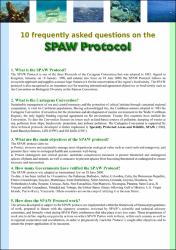Mostrar el registro sencillo del ítem
10 frequently asked questions on the SPAW Protocol
| Autor | United Nations Environment Programme (UNEP) | |
| Autor | Caribbean Environment Programme (CEP) | |
| Fecha de admisión | 2023-12-12T13:43:49Z | |
| Fecha disponible | 2023-12-12T13:43:49Z | |
| Año | 2023 | |
| Citación | United Nations Environment Programme (UNEP), Caribbean Environment Programme (CEP) (2023). 10 frequently asked questions on the SPAW Protocol. Kingston, Jamaica: UNEP Caribbean Environmental Programme. Recuperado de: | es |
| URI | https://bvearmb.do/handle/123456789/3739 | |
| Sinopsis | Contents: 1. What is the SPAW Protocol? -- 2. What is the Cartagena Convention? -- 3. What are the main objectives of the SPAW protocol? -- 4. How many Governments have ratified the SPAW Protocol? -- 5. How does the SPAW Protocol work? -- 6. What are some of the main obligations following ratification? -- 7. How can countries get assistance to implement the obligations of the SPAW Protocol? -- 8. What are the main benefits for countries from ratification? -- 9. How does a country ratify/accede to the SPAW Protocol? -- 10. Which partners are involved in the SPAW Protocol? | es |
| Idioma | English | es |
| Publicado | Kingston, Jamaica: UNEP Caribbean Environmental Programme | es |
| Derechos | © United Nations Environment Programme (UNEP); Caribbean Environment Programme (CEP), 2023. | es |
| Materia | Gestión ambiental - Políticas y normas | es |
| Materia | Gestión ambiental - Legislación y Derecho | es |
| Materia | Acuerdos internacionales | es |
| Materia | Biodiversidad | es |
| Materia | Conservación ambiental | es |
| Título | 10 frequently asked questions on the SPAW Protocol | es |
| Tipo de material | Booklet | es |
| Tipo de contenido | News - Informative | es |
| Acceso | Open | es |
| Audiencia | Technicians, professionals and scientists | es |
Ficheros en el ítem
Este ítem aparece en la(s) siguiente(s) colección(es)
-
Gestión ambiental [2959]


